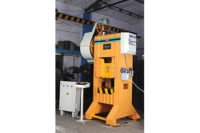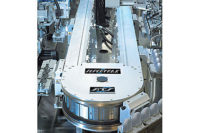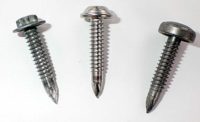It has become fashionable lately for some U.S. companies to tout how they’ve reshored production from overseas. Baldor Electric Co. isn’t one of them—it never left. The company has been manufacturing electric motors, drives, bearings and other motion control products in the United States for decades.
Over the past several years, the company has invested millions of dollars to improve, expand and build its portfolio of U.S. assembly facilities, creating hundreds of jobs. By investing in U.S. manufacturing, Baldor believes it gains advantages in quality, customer responsiveness and new product development.
Bearing Assembly
Baldor’s assembly plant in Marion, NC, makes spherical and tapered roller bearings. The facility opened its doors in November 1996, earned ISO certification in 1998, and won an Industry Week Best Plant award in 2004.
Buoyed by early success, some facilities might have rested on their laurels. Not Baldor. In August 2012, the company completed work on a $17.7 million project to expand the facility by 96,000 square feet. (All totaled, the facility now spans some 256,000 square feet, employing 135 people in three shifts.)
The expansion project was launched with the goal of growing unit sales by 47 percent over the next four years.
“Ninety-seven percent of our sales are currently in North America,” explains Mark Earley, plant manager. “So there’s a huge untapped market for our products internationally, and we see [the expansion] as an avenue for growth.”
The expansion will house five new manufacturing cells. Two of the cells will be operating by midyear. The remaining three will be implemented as sales grow over the next two years.
The factory’s output is split almost evenly between spherical roller bearings and tapered roller bearings. The plant produces spherical roller bearings in bore sizes ranging from 1.25 to 15 inches. Tapered roller bearings come in bore sizes ranging from 1.1875 to 12 inches.
What sets the Marion plant apart is how deftly it handles both high-volume, low-mix production and low-volume, high-mix production. Approximately 70 percent of the plant’s output is product that will be kept in stock for immediate sale. Another 25 percent—representing some 4,700 part numbers—is built on demand with a 24-hour internal lead time. The remaining 5 percent are specials.
That ability to quickly produce so many part numbers on-demand gives Baldor an edge.
“Statistically, you can’t model the behavior of those part numbers,” explains Earley. “You either have too much inventory or not enough. So we invest in component inventory, leverage the setups on volume parts, and slipstream the low-volume components to the build centers. We can build any quantity, even a lot size of one.
“That gives us an advantage over [cheap overseas competition]. For them to compete with the broad line of bearings we can provide, they would have to invest in a significant amount of inventory.”
Fulfilling some 500 orders daily, the build-on-demand area has setup and changeover down to a science. Workstations are equipped with quick-change tooling. Settings on assembly presses, fastening tools and even grease dispensing equipment are configured automatically based on the incoming order.
High-volume tapered roller bearings are produced on an asynchronous multistation automated assembly system. Baldor had been purchasing the bearings from a supplier in India, but became disenchanted with the quality, cost and on-time delivery of the product. In 2009, Baldor decided to produce the bearings in-house, investing $14.2 million in the project.
Although lead times and on-time delivery were the main reasons for insourcing, the move has also paid dividends in product development. “By bringing production in-house, we can make our own designs and implement them more quickly. We’ve already launched two new products,” explains Earley. “Our previous partner was unwilling to invest in the tooling to launch new products.”
The line is a marvel. Six-axis robots load and unload parts and machines. Vision systems inspect assemblies. An innovative, shop-built machine feeds rollers into the system via a continuous plastic strip. This prevents damage to the precision rollers and ensures that each bearing is supplied with rollers from the same lot (as opposed to drawing them from a random assortment, as with a vibratory bowl), says Kent Aldridge, a senior manufacturing engineer at the facility.
As dazzling as the assembly technology is, Earley says the human workforce is the real star of the show at the Marion plant. The numbers speak for themselves:
- 35 percent of the hourly workforce achieved perfect attendance.
- 33 percent of employees have at 10 years of service.
- 35 percent of hourly employees are graduates of the North Carolina Department of Labor (NCDOL) apprenticeship program.
- 54 percent of managers were promoted from hourly positions.
The plant has received a Safety Excellence award from the NCDOL 11 straight years, and two years ago, the facility enjoyed a streak of 391 days without an OSHA-reportable incident.
“What sets us apart is our workforce,” says Earley. “From production to safety to everything, they take ownership of their processes.”
Building Big Motors
Baldor’s assembly plant in Kings Mountain, NC, produces large electric motors for a wide range of industrial equipment, including pumps, fans, compressors, mining machinery, aggregate machinery, rolling mills and test stands. The plant makes above-NEMA AC induction motors (250 to 3,500 hp), DC motors (75 to 4,000 hp), AC and DC air- or water-cooled mining motors (1 to 2,000 hp), and hermetic HVAC motors (200 to 1,500 hp).
Production at Kings Mountain is high-mix, low-volume. Large electric motors are typically made to order in lot sizes of one to three.
A vertically integrated facility, the plant began production in 1983. The operation was ISO 9001 certified in 1992 and was recertified to ISO 9001/2000 in 2003.
Lean is a way of life here. The first kaizen event was held in January 2001. Since then, the operation has conducted more than 200 kaizen events involving some 600 people. Today, 128 areas in the plant are under Lean Six Sigma audit control.
Before any parts are produced or assembled, incoming raw materials are checked to ensure they comply with design specifications. For example, magnet wire samples undergo tests that involve elongation, bending and baking. High-voltage testing is also done to ensure the windings will withstand voltage surges.
The concentricity of copper rotor bars is critical to eliminating the sources of motor vibration. So before the bars are assembled, technicians measure concentricity top to bottom and side to side throughout the length of the bar.
Lamination steel used in the stator plays a key role in maintaining consistent and efficient electrical performance. So, incoming lamination steel undergoes Epstein and Franklin tests to measure its chemical, physical and insulating properties.
The process of making a motor begins with machining a rotor shaft from a steel blank. All the surfaces and shoulders are turned in a single process. Next, the keyway and the centering holes at the end of the shaft are milled. Shafts and journals are machined to a tolerance of ±0.0005 inch.
The temperature of the facility is carefully controlled—not just for operator comfort, but to ensure consistent, high-precision machining.
Because low vibration and bearing life are so important, Baldor finish-grinds the entire length of the shaft, including the rotor core, where a perfect fit with the shaft is essential to keeping motor vibration in check.
Making laminations begins with punching the stator and rotor blanks. Precise stator lamination geometry is important for optimizing heat transfer inside the motor. Notching the slots provides a clean edge that won’t damage the magnet wire during the winding process.
Producing laminations in-house enables Baldor to maintain tight toleranaces. Notching also makes it easier and faster to adjust slot configurations and change designs.
Random samples of rotor and stator laminations are checked for dimensional consistency.
After heat-treating, rotor laminations cool and shrink on an arbor. Then, the stack is compressed from top to bottom. A rotor stack might contain thousands of laminations.
Next, the stack goes to the die-caster. Molten aluminum enters the core from the bottom. This forces air out through the top and prevents rotor porosity.
After die-casting, Baldor hones the rotor bore. This yields a perfectly sized and round bore, which is important for minimizing vibration. After honing, the rotor core is heated so it will expand to accept the shaft. Gradually cooling the assembly relieves internal stresses and reduces vibration.
Finally, the assembled shaft and rotor are balanced. The rotor’s copper bars are not restricted, and are able to maintain their geometry as they heat up. The bars are brazed to the end-rings with an exclusive process that prevents warpage and bar breakage. A turning lathe trues up the rings and brings them to the right size. Prior to vibration testing, the assembly is given a protective coating.
As with the rotor cores, precision and concentricity are critical to assembling high-quality stator cores. To ensure a tight fit between laminations, the core is compressed, and welded straps are applied.
Baldor applied lean and Six Sigma to its coil cell and reduced cycle time from 21 days to 7.5 hours. All the key processes in this cell—such as winding, shaping and insulating—are computer-controlled. For example, the coil winder maintains constant tension on the wire as the coil diameter builds.
A robot repeatably and reliably applies insulating tape to the periphery of the magnet wire. During taping, insulation tension and overlaps are held to exacting specifications.
The coils might be produced with automated equipment, but the process of inserting them into the stator is still done manually. Slot lining and insulation paper make it easy to insert the coils without damaging the insulating tape.
Before going to varnish, the stator gets a surge test to ensure coil integrity. Technicians also perform a hi-pot test of the windings as a final check.
From there, the stators undergo vacuum pressure impregnation. This gives the assembly some rigidity and ensures the coils are adequately insulated. Once in the tank, the stator is subjected to a vacuum, which pulls air out of the tape and windings. Varnish is introduced under vacuum; then pressure is applied to force resin into the wire and tape. When the stator emerges from the vacuum chamber, it gets baked to cure the resin. During baking, the stators are kept horizontal and rotated to improve distribution, penetration and utilization of the varnish.
Next, the motor frame is lowered onto the stator core, and the rotor shaft assembly is inserted. Finally, the bearings, bearing caps, end brackets, fan and fan cover are installed to complete the assembly.
As a final check of quality, the plant can perform full-load dynamometer testing on the motors up to 4,500 hp and 7,200 volts. The facility also regularly tests motors according to American Petroleum Institute standard 541.
For more information on Baldor, read these articles:









